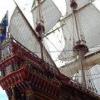Supplies of the Ship Modeler's Handbook are running out. Get your copy NOW before they are gone! Click on photo to order.
×
-
Posts
841 -
Joined
-
Last visited
Reputation Activity
-
 michaelpsutton2 got a reaction from Canute in Ship paintings
michaelpsutton2 got a reaction from Canute in Ship paintings
All I do are the "ship Portraits" and i am jealous. I wish i had your talent! Great work, thanks for sharing
-
 michaelpsutton2 got a reaction from Canute in "Made Mast" Diameter
michaelpsutton2 got a reaction from Canute in "Made Mast" Diameter
That actually makes sense. ou are of course correct. Te given diameter is at the partners. The fish terminate some what above that point. I should have realized that
Thanks
-
 michaelpsutton2 got a reaction from DonnRW in HMAV Bounty: Gaff-Boom Rigging?
michaelpsutton2 got a reaction from DonnRW in HMAV Bounty: Gaff-Boom Rigging?
On the McKay drawing posted by Gregory the rigging attached to the gaff is as follows: Vangs which lead down from the peak of the gaff to the deck on either side, the peak halliard which leads to a block at the mizzen mast head, mizzen topsail braces which lead from the mizzen topsail yard arms to small blocks sized to the gaff peak, and the brails used to gather the mizzen sail to the gaff and the mast. The peak halliard appears to be a simple single lead. There would also have to be a throat halliard which would be used to haul the end of the gaff at the mast up under the mizzen top. It would hoist to a spot roughly 2/3-3/4 the length of the mizzen mast head below the underside of the tressle trees. The peak would be hoisted to about the same angle as the mizzne stay or mizzen topmast stay.
-
 michaelpsutton2 got a reaction from Matrim in HMAV Bounty: Gaff-Boom Rigging?
michaelpsutton2 got a reaction from Matrim in HMAV Bounty: Gaff-Boom Rigging?
On the McKay drawing posted by Gregory the rigging attached to the gaff is as follows: Vangs which lead down from the peak of the gaff to the deck on either side, the peak halliard which leads to a block at the mizzen mast head, mizzen topsail braces which lead from the mizzen topsail yard arms to small blocks sized to the gaff peak, and the brails used to gather the mizzen sail to the gaff and the mast. The peak halliard appears to be a simple single lead. There would also have to be a throat halliard which would be used to haul the end of the gaff at the mast up under the mizzen top. It would hoist to a spot roughly 2/3-3/4 the length of the mizzen mast head below the underside of the tressle trees. The peak would be hoisted to about the same angle as the mizzne stay or mizzen topmast stay.
-
 michaelpsutton2 got a reaction from Matrim in HMAV Bounty: Gaff-Boom Rigging?
michaelpsutton2 got a reaction from Matrim in HMAV Bounty: Gaff-Boom Rigging?
Can't beat Lees "Masting & Rigging English Ships of War" or Steels Mast Making & Rigging which is available on-line at:
http://www.hnsa.org/resources/manuals-documents/age-of-sail/the-elements-and-practice-of-rigging-and-seamanship/
My question would be did the HMS Bounty have a boom? I would think a gaff with a loose footed mizzen sail., not technically a driver or a spanker. Any one else have a thought on that?
The 1960's replica had a boom and a true spanker, but it's rig incorporated a cornucopia of obvious anachronisms, not the least of which were the main and mizzen royals.
We do have, or at least I thought we had, a pretty definitive list of spars as fitted by Bligh. I would not depart from that.
-
 michaelpsutton2 got a reaction from mtaylor in Confederacy Problem
michaelpsutton2 got a reaction from mtaylor in Confederacy Problem
If I understand correctly , I would think you would be better off building a couple of taller gun carriages.
-
 michaelpsutton2 got a reaction from thibaultron in A quick clarification
michaelpsutton2 got a reaction from thibaultron in A quick clarification
I believe that there were cleats seized to the shrouds a couple of feet above the sheer poles. It's a practice used on recreational sail up to this very day. Just google shroud cleat and you can see what they look like in the 21st century. I would mention that I do not think that many of them were carbon fiber a century ago. I would put my money behind wood.
-
 michaelpsutton2 got a reaction from mtaylor in A quick clarification
michaelpsutton2 got a reaction from mtaylor in A quick clarification
I believe that there were cleats seized to the shrouds a couple of feet above the sheer poles. It's a practice used on recreational sail up to this very day. Just google shroud cleat and you can see what they look like in the 21st century. I would mention that I do not think that many of them were carbon fiber a century ago. I would put my money behind wood.
-
 michaelpsutton2 got a reaction from blackjoke in Cruizer-class Brig-Sloops of the Royal Navy
michaelpsutton2 got a reaction from blackjoke in Cruizer-class Brig-Sloops of the Royal Navy
If you look at the plans for the Larne of 1814 or the Levant of 1713 the arrangement of the planks is very close to that on the Cruizer models. They are of course larger 20 gun, ship rigged sloops. I certainly am not saying they are in anyway connected just visually similar and serve to illustrate what the Cruizer plans would look like if they matched the models
HMS Cruizer class 1810 web-1
-
 michaelpsutton2 got a reaction from TomShipModel in Cruizer-class Brig-Sloops of the Royal Navy
michaelpsutton2 got a reaction from TomShipModel in Cruizer-class Brig-Sloops of the Royal Navy
If you look at the plans for the Larne of 1814 or the Levant of 1713 the arrangement of the planks is very close to that on the Cruizer models. They are of course larger 20 gun, ship rigged sloops. I certainly am not saying they are in anyway connected just visually similar and serve to illustrate what the Cruizer plans would look like if they matched the models
HMS Cruizer class 1810 web-1
-
 michaelpsutton2 got a reaction from uss frolick in Cruizer-class Brig-Sloops of the Royal Navy
michaelpsutton2 got a reaction from uss frolick in Cruizer-class Brig-Sloops of the Royal Navy
If you look at the plans for the Larne of 1814 or the Levant of 1713 the arrangement of the planks is very close to that on the Cruizer models. They are of course larger 20 gun, ship rigged sloops. I certainly am not saying they are in anyway connected just visually similar and serve to illustrate what the Cruizer plans would look like if they matched the models
HMS Cruizer class 1810 web-1
-
 michaelpsutton2 got a reaction from mtaylor in Cruizer-class Brig-Sloops of the Royal Navy
michaelpsutton2 got a reaction from mtaylor in Cruizer-class Brig-Sloops of the Royal Navy
The rigged model in Preble Hall and the unrigged model in the NMM look very much like most of the portraits of Cruizer class brigs. That is to say on the broadside top to bottom: 1st a Top Rail (rubbing rail) 2nd a strake of thick stuff, 3rd three or four strakes of regular planking containing the gun ports, 4th a reducing plank, 5th the main wales. However the plans do not show any thick stuff or reducing strake. In addition though there is a rail that follows the line of the sheer about midway up the gun ports running for and aft. I cannot find a painying drawing or etching that shows a ship with the rail.
-
 michaelpsutton2 got a reaction from Canute in Cruizer-class Brig-Sloops of the Royal Navy
michaelpsutton2 got a reaction from Canute in Cruizer-class Brig-Sloops of the Royal Navy
The rigged model in Preble Hall and the unrigged model in the NMM look very much like most of the portraits of Cruizer class brigs. That is to say on the broadside top to bottom: 1st a Top Rail (rubbing rail) 2nd a strake of thick stuff, 3rd three or four strakes of regular planking containing the gun ports, 4th a reducing plank, 5th the main wales. However the plans do not show any thick stuff or reducing strake. In addition though there is a rail that follows the line of the sheer about midway up the gun ports running for and aft. I cannot find a painying drawing or etching that shows a ship with the rail.
-
 michaelpsutton2 got a reaction from TomShipModel in Cruizer-class Brig-Sloops of the Royal Navy
michaelpsutton2 got a reaction from TomShipModel in Cruizer-class Brig-Sloops of the Royal Navy
The rigged model in Preble Hall and the unrigged model in the NMM look very much like most of the portraits of Cruizer class brigs. That is to say on the broadside top to bottom: 1st a Top Rail (rubbing rail) 2nd a strake of thick stuff, 3rd three or four strakes of regular planking containing the gun ports, 4th a reducing plank, 5th the main wales. However the plans do not show any thick stuff or reducing strake. In addition though there is a rail that follows the line of the sheer about midway up the gun ports running for and aft. I cannot find a painying drawing or etching that shows a ship with the rail.
-
 michaelpsutton2 got a reaction from Karleop in Pride of Baltimore II by Karleop - FINISHED - Model Shipways - 1:64
michaelpsutton2 got a reaction from Karleop in Pride of Baltimore II by Karleop - FINISHED - Model Shipways - 1:64
very nice indeed
-
 michaelpsutton2 got a reaction from mtaylor in Pandora by marsalv - FINISHED - 1:52
michaelpsutton2 got a reaction from mtaylor in Pandora by marsalv - FINISHED - 1:52
I don't think I could get the clean detail if I was working life size!
-
 michaelpsutton2 got a reaction from EricWilliamMarshall in Book Suggestions
michaelpsutton2 got a reaction from EricWilliamMarshall in Book Suggestions
It's not nautical but the sharps series of books is about the same period but in the British Army. or something a bit lighter...the Flashman series by George MacDonald Fraser.
-
 michaelpsutton2 got a reaction from mtaylor in Book Suggestions
michaelpsutton2 got a reaction from mtaylor in Book Suggestions
It's not nautical but the sharps series of books is about the same period but in the British Army. or something a bit lighter...the Flashman series by George MacDonald Fraser.
-
 michaelpsutton2 got a reaction from druxey in Book Suggestions
michaelpsutton2 got a reaction from druxey in Book Suggestions
It's not nautical but the sharps series of books is about the same period but in the British Army. or something a bit lighter...the Flashman series by George MacDonald Fraser.
-
 michaelpsutton2 got a reaction from Canute in Book Suggestions
michaelpsutton2 got a reaction from Canute in Book Suggestions
It's not nautical but the sharps series of books is about the same period but in the British Army. or something a bit lighter...the Flashman series by George MacDonald Fraser.
-
 michaelpsutton2 reacted to Gerhardvienna in USS CAIRO by Gerhardvienna - RADIO - live steam
michaelpsutton2 reacted to Gerhardvienna in USS CAIRO by Gerhardvienna - RADIO - live steam
Hi John
If you mean the 21 pages from the Vicksburg NPS, here they are. That was one of the first files I had for the build, seems that the outer lines are close to the Bob Hill plans.
Best regards
Gerhard
150 Years Civil War.pdf
-
 michaelpsutton2 got a reaction from mtaylor in Flag on mizzen/boom
michaelpsutton2 got a reaction from mtaylor in Flag on mizzen/boom
The ensign took up about two thirds the length of the staff above the taffrail. So the length of the staff can be workked out by the size of the correct ensign for the date and rate of the ship.
-
 michaelpsutton2 reacted to igorcap in Classical head figure of Lion
michaelpsutton2 reacted to igorcap in Classical head figure of Lion
Classical head figure of Lion. Suitable for sailing ships of 17-18 centuries - England, Holland (last), Spain, Sweden, Denmark and others.
-
 michaelpsutton2 got a reaction from mtaylor in Fantastic finish on this model. Any ideas on how its done?
michaelpsutton2 got a reaction from mtaylor in Fantastic finish on this model. Any ideas on how its done?
I don't think that is oak. It's copper, right? There are various acidic solutions for the green patina on copper.
-
 michaelpsutton2 got a reaction from Eddie in Securing stays to mast caps
michaelpsutton2 got a reaction from Eddie in Securing stays to mast caps
The "notebook' section in Chpelle's "North American Fishing schooner has some details on these fittings









.thumb.jpeg.fc5d633a7b34428fcf19419a73d56d55.jpeg)

